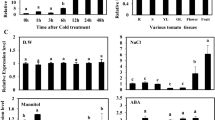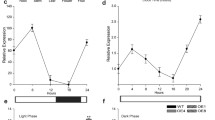Abstract
Cold and freezing damage to plants can be mitigated by inducible factors during an acclimation period. DEA1 is a circadian-regulated tomato (Solanum lycopersicum) gene with sequence similarity to EARLI1, an Arabidopsis thaliana gene that confers cold protection. To investigate whether DEA1 was responsive to environmental variables such as cold, cold-treated tomatoes were analyzed for DEA1 expression. DEA1 transcript accumulated in response to cold, and the rapidity of the cold-induced transcript accumulation was regulated by the circadian rhythm. To test whether DEA1 could protect cells from freezing damage, we transformed the yeast, Pichia pastoris, with an inducible DEA1 construct. Yeast cells transformed with the gene survived freezing at a significantly higher rate than control strains and a strain expressing the LacZ gene. Transgenic tomato plants over-expressing or knocking down DEA1 transcript levels did not have an altered phenotype with respect to cold- or pathogen-susceptibility relative to control plants.
Similar content being viewed by others
Abbreviations
- ROS:
-
Reactive oxygen species
- FAD:
-
Fatty acid desaturase
- ZT:
-
Zeitgeber time
- MMH:
-
Minimal methanol medium with histidine
- BGMY:
-
Buffered glycerol complex medium
- 8CM:
-
Eight cysteine motif
- LD:
-
Long day
- SD:
-
Short day
- DD:
-
Constant darkness
- LL:
-
Constant light
- AA:
-
Arachidonic Acid
- PTGS:
-
Post-transcriptional gene silencing
- Pst:
-
Pseudomonas syringae pathovar tomato
- LHC:
-
Light harvesting complex
References
Artus NN, Uemura M, Steponkus PL, Gilmour SJ, Lin C, Thomashow MF (1996) Constitutive expression of the cold-regulated Arabidopsis thaliana COR15a gene affects both chloroplast and protoplast freezing tolerance. Proc Natl Acad Sci USA 93:13404–13409
Bostock R (2005) Signal crosstalk and induced resistance: straddling the line between cost and benefit. Annu Rev Phytopathol 43:545–580
Bubier J, Schlappi M (2004) Cold induction of EARLI1, a putative Arabidopsis lipid transfer protein, is light and calcium dependent. Plant Cell Environ 27:929–936
Cregg JM, Russell KA (1998) Transformation. In: Higgins DR, Cregg JM (eds) Pichia protocols. Methods in molecular biology, Humana Press, Totowa, NJ pp 27–39
Fowler SG, Cook D, Thomashow MF (2005) Low temperature induction of Arabidopsis CBF1, 2, and 3 is gated by the circadian clock. Plant Physiol 137:961–968
Hammond SM, Caudy AA, Hannon GJ (2001) Post-transcriptional gene silencing by double-stranded RNA. Nat Rev Gen 2:110–119
Harmer SL, Hogenesch JB, Straume M, Chang H-S, Han B, Zhu T, Wang X, Kreps J.A, Kay SA (2000) Orchestrated transcription of key pathways in Arabidopsis by the circadian clock. Science 290:2110–2113
He CY, Zhang JS, Chen SY (2002) A soybean gene encoding a proline-rich protein is regulated by salicylic acid, an endogenous circadian rhythm and by various stresses. Theor Appl Genet 104:1125–1131
Hoefgen R, Willmitzer L (1988) Storage of competent cells for Agrobacterium transformation. Nucleic Acids Res 16:9877
Honjoh K-I, Oda Y, Takata R, Miyamoto T, Hatano S (1999) Introduction of the hiC6 gene, which encodes a homologue of a late embryogenesis abundant (lea) protein, enhances freezing tolerance of yeast. J Plant Physiol 155:509–512
Honjoh K-I, Shimizu H, Nagaishi N, Matsumoto H, Suga K, Miyamoto T, Iio M, Hatano S (2001) Improvement of freezing tolerance in transgenic tobacco leaves by expressing the hiC6 gene. Biosci Biotechnol Biochem 65:1796–1804
Horsch RB, Fry JE, Hoffmann NL, Eichholtz D, Rogers SG, Fraley RT (1985) A simple and general method for transferring genes into plants. Science 227:1229–1231
Imai R, Chang L, Ohta A, Bray EA, Takagi M (1996) A lea-class gene of tomato confers salt and freezing tolerance when expressed in Saccharomyces cerevisiae. Gene 170:243–248
Jones TL, Tucker DE, Ort DR (1998) Chilling delays circadian pattern of sucrose phosphate synthase and nitrite reductase activity in tomato. Plant Physiol 118:149–158
Knight VI, Wang H, Lincoln JE, Lulai EC, Gilchrist DG, Bostock RM (2001) Hydroperoxides of fatty acids induce programmed cell death in tomato protoplasts. Physiol Mol Plant Pathol 59:277–286
Kreps JA, Simon AE (1997) Environmental and genetic effects on circadian clock-regulated gene expression in Arabidopsis. Plant Cell 9:297–304
Laemmli UK (1970) Cleavage of structural proteins during the assembly of the head of bacteriophage T−4. Nature 227:680–685
Martin B, Ort DR (1985) The recovery of photosynthesis in tomato Lycopersicon esculentum cultivar floramerica subsequent to chilling exposure. Photosyn Res 6:121–132
Martino-Catt S, Ort DR (1992) Low temperature interrupts circadian regulation of transcriptional activity in chilling-sensitive plants. Proc Natl Acad Sci USA 89:3731–3735
Meyer H, Thienel U, Piechulla B (1989) Molecular characterization of the diurnal-circadian expression of the chlorophyll a-b-binding proteins in leaves of tomato and other dicotyledonous and monocotyledonous plant species. Planta 180:5–15
Millar A, Kay SA (1996) Integration of circadian and phototransduction pathways in the network controlling CAB gene transcription in Arabidopsis. Proc Natl Acad Sci USA 93:15491–15496
Mol JNM, VanDerKrol AR, VanTunen AJ, VanBlokland R, DeLange P, Stuitje AR (1990) Regulation of plant gene expression by antisense RNA. FEBS Lett 268:427–430
Ramos A, Pérez-Solís E, Ibáñez C, Casado R, Collada C, Gómez L, Aragoncillo C, Allona I (2005) Winter disruption of the circadian clock in chestnut. Proc Natl Acad Sci USA 102:7037–7042
Salome PA, Robertson McClung C (2005) PSEUDO-RESPONSE REGULATOR 7 and 9 are partially redundant genes essential for the temperature responsiveness of the Arabidopsis circadian clock. Plant Cell 17:791–803
Sambrook J, Russell DW (2001) Molecular cloning: a laboratory manual. Cold Spring Harbor Laboratory Press, Cold Spring Harbor, NY
Sassenrath GF, Ort DR, Portis ARJ (1990) Impaired reductive activation of stromal bisphosphatases in tomato leaves following low-temperature exposure at high light. Arch Biochem Biophys 282:302–308
Sauerbrunn N, Schlaich NL (2004) PCC1: a merging point for pathogen defence and circadian signalling in Arabidopsis. Planta 218:552–561
Steponkus PL (1984) Role of the plasma membrane in freezing injury and cold acclimation. Annu Rev Plant Physiol 35:543–584
Steponkus PL, Uemura M, Joseph RA, Gilmour SJ, Thomashow MF (1998) Mode of action of the COR15a gene on the freezing tolerance of Arabidopsis thaliana. Proc Natl Acad Sci USA 95:14570–14575
Sukumaran NP, Weiser CJ (1972) An excised leaflet test for evaluating potato frost tolerance. Hortscience 7:467–468
Thomashow MF (1999) Plant cold acclimation: freezing tolerance genes and regulatory mechanisms. Annu Rev Plant Physiol Plant Mol Biol 50:571–599
Thomashow MF (2001) So what’s new in the field of plant cold acclimation? Lots! Plant Physiol. 125:89–93
Weyman PD, Pan Z, Feng Q, Gilchrist DG, Bostock RM (2006) A circadian rhythm-regulated tomato gene is induced by arachidonic acid and Phythophthora infestans infection. Plant Physiol 140:235–248
Wilkosz R, Schlappi M (2000) A gene expression screen identifies EARLI1 as a novel vernalization-responsive gene in Arabidopsis thaliana. Plant Mol Biol 44:777–787
Wise RR (1995) Chilling-enhanced photooxidation: the production, action and study of reactive oxygen species produced during chilling in the light. Photosyn Res 45:79–97
Acknowledgements
We thank Douglas Cook, Stacey Harmer, Steve Marek, and Miin-Huey Lee for helpful discussions about the data. We also thank Betsy Harbert, Dan Johnson, Jim Lincoln, and Barney Ward for their assistance with aspects of this study. This project was made possible by grant 96-35303-3238 from the USDA-NRI program, and the National Science Foundation Cooperative Agreement No. BIR−8920216 to CEPRAP.
Author information
Authors and Affiliations
Corresponding author
Rights and permissions
About this article
Cite this article
Weyman, P.D., Pan, Z., Feng, Q. et al. DEA1, a circadian- and cold-regulated tomato gene, protects yeast cells from freezing death. Plant Mol Biol 62, 547–559 (2006). https://doi.org/10.1007/s11103-006-9039-5
Received:
Accepted:
Published:
Issue Date:
DOI: https://doi.org/10.1007/s11103-006-9039-5




